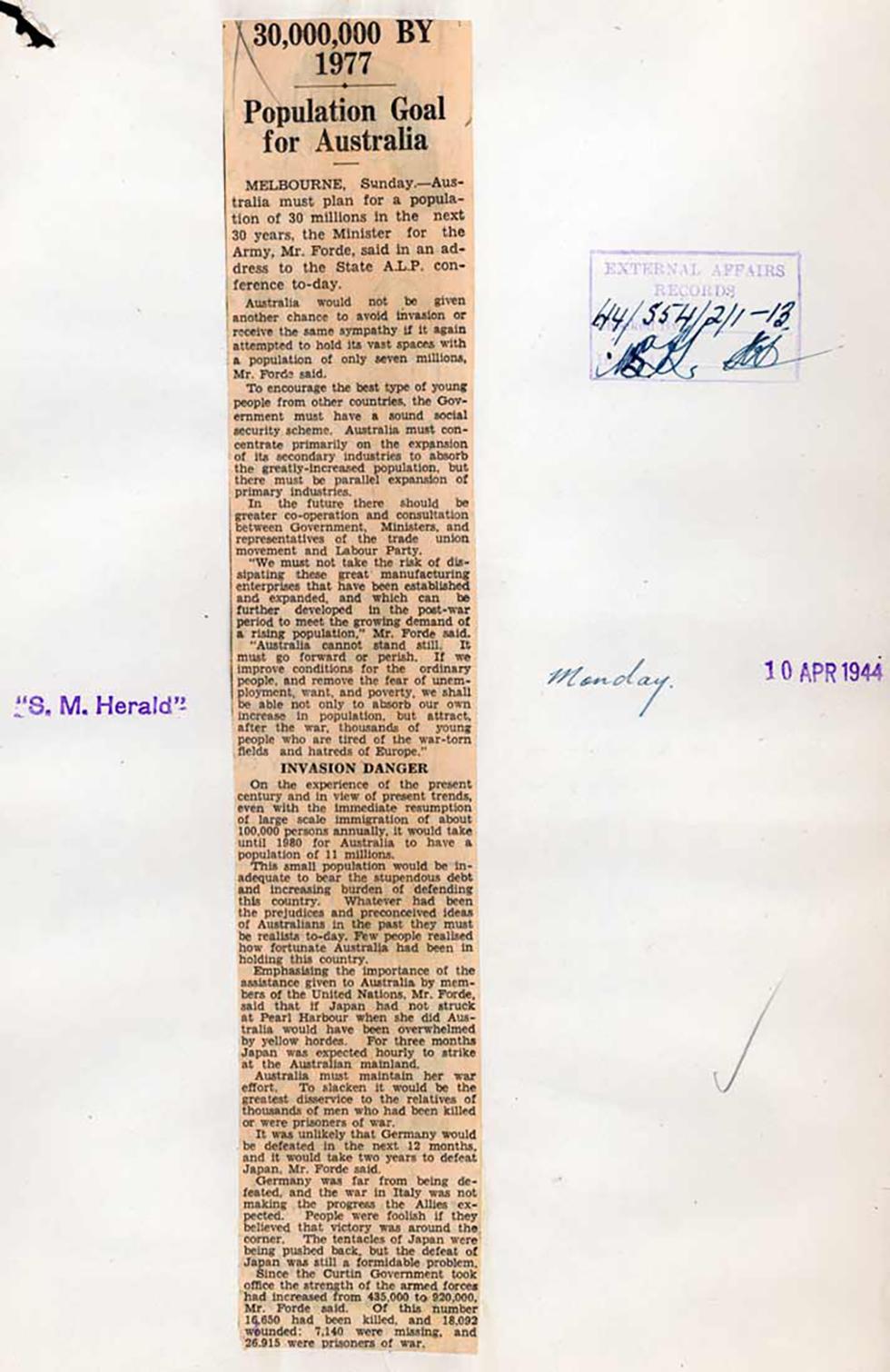
This 1944 article from the Sydney Morning Herald promotes a population goal of 30 million people by 1977 to protect Australia from invasion.
Aboriginal and Torres Strait Islander people should be aware that the National Archives' website and collection contain the names, images and voices of people who have died.
Some records include terms and views that are not appropriate today. They reflect the period in which they were created and are not the views of the National Archives.


This 1944 article from the Sydney Morning Herald promotes a population goal of 30 million people by 1977 to protect Australia from invasion.
[Newspaper clipping attached to a blank piece of paper, stamped '"S.M. Herald"', '10 APR 1944'. Near the stamped date is handwritten 'Monday'. The page has also been stamped 'EXTERNAL AFFAIRS RECORDS', with the record number '44/554/2/1-13' and an illegible signature handwritten inside the stamp.]
[Headline:] 30,000,000 BY 1977
[Headline:] Population Goal for Australia
MELBOURNE, Sunday. - Australia must plan for a population of 30 millions in the next 30 years, the Minister for the Army, Mr. Forde, said in an address to the State A.L.P. conference to-day.
Australia would not be given another chance to avoid invasion or receive the same sympathy if it again attempted to hold its vast spaces with a population of only seven millions, Mr. Forde said.
To encourage the best type of young people from other countries, the Government must have a sound social security scheme. Australia must concentrate primarily on the expansion of its secondary industries to absorb the greatly-increased population, but there must be a parallel expansion of primary industries.
In the future there should be greater co-operation and consultation between Government, Ministers, and representatives of the trade union movement and Labour Party [sic].
"We must not take the risk of dissipating these great manufacturing enterprises that have been established and expanded, and which can be further developed in the post-war period to meet the growing demand of a rising population," Mr. Forde said.
"Australia cannot stand still. It must go forward or perish. If we improve conditions for the ordinary people, and remove the fear of unemployment, want, and poverty, we shall be able not only to absorb our own increase in population, but attract, after the war, thousands of young people who are tired of the war-torn fields and hatreds of Europe."
[Subheading:] INVASION DANGER
On the experience of the present century and in view of present trends, even with the immediate resumption of large scale immigration of about 100,000 persons annually, it would take until 1980 for Australia to have a population of 11 millions.
This small population would be inadequate to bear the stupendous debt and increasing burden of defending this country. Whatever had been the prejudices and preconceived ideas of Australians in the past they must be realists to-day [sic]. Few people realised how fortunate Australia had been in holding this country.
Emphasising the importance of the assistance given to Australia by members of the United Nations, Mr. Forde, [sic] said that if Japan had not struck at Pearl Harbour when she did Australia would have been overwhelmed by yellow hordes. For three months Japan was expected hourly to strike at the Australian mainland.
Australia must maintain her war effort. To slacken it would be the greatest disservice to the relatives of thousands of men who had been killed or were prisoners of war.
It was unlikely that Germany would be defeated in the next 12 months, and it would take two years to defeat Japan, Mr. Forde said.
Germany was far from being defeated, and the war in Italy was not making the progress the Allies expected. People were foolish if they believed that victory was around the corner. The tentacles of Japan were being pushed back, but the defeat of Japan was still a formidable problem.
Since the Curtin Government took office the strength of the armed forces had increased from 435,000 to 920,000, Mr. Forde said. Of this number 16,650 had been killed, and 18,092 wounded: 7,140 were missing, and 26,915 were prisoners of war.
Learn how to interpret primary sources, use our collection and more.
